Lagman is a flavorful stir-fry dish served with homemade noodles. Excite your guests with fresh flavors and delicious textures by giving Lagman a try!
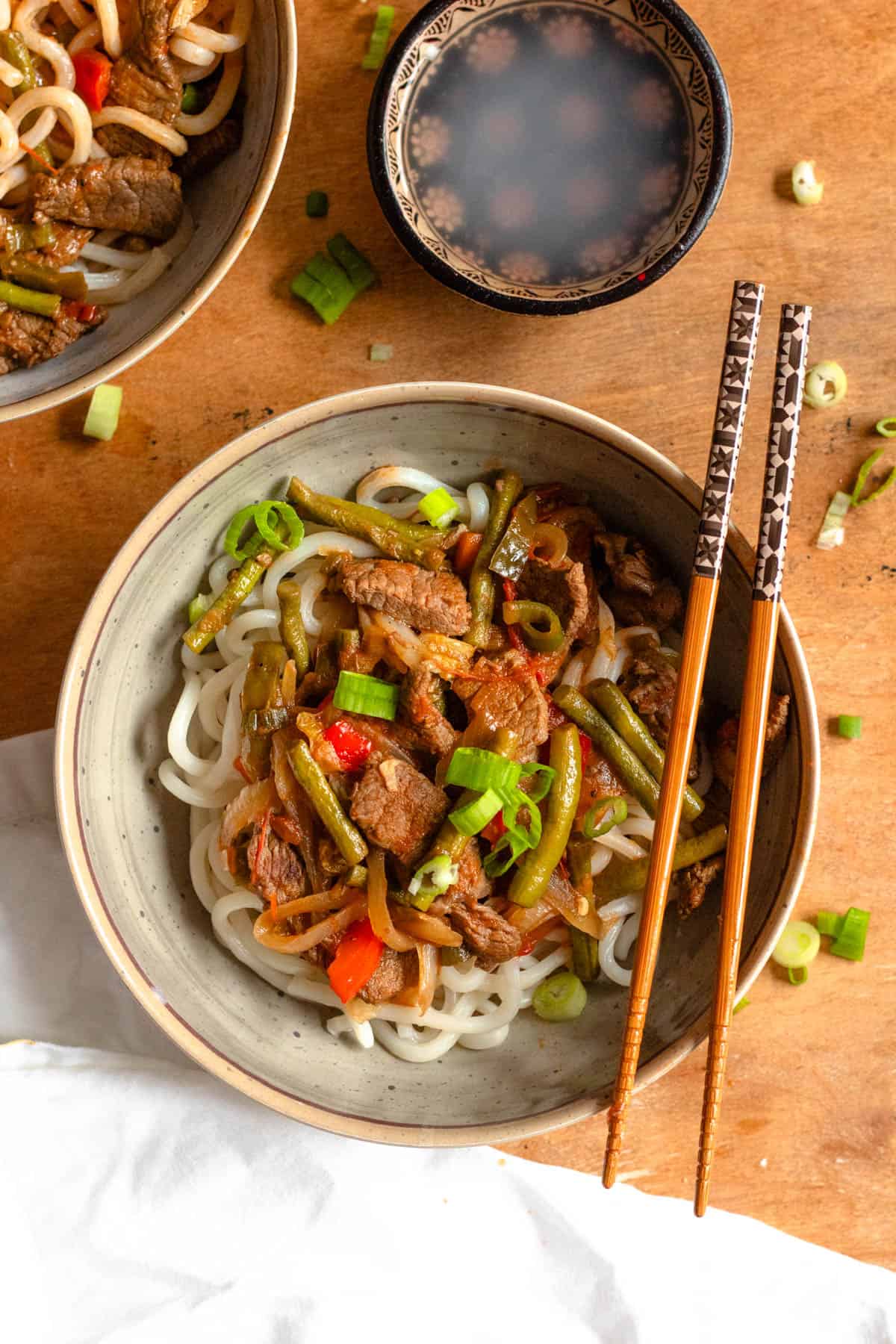
Hello Reader! I try my hardest to research recipes as best as I can before posting to ensure I am representing each culture correctly. If this recipe is from your country and I have made a mistake or you have suggestions for how to make it more authentic, I would love to hear! Please leave a comment below letting me know what should be different, and I will rework the recipe. It is always my intention to pay homage and respect to each cultural dish that I cook. Thanks for reading!
Lagman (or Laghman) is a traditional Kyrgyzstan recipe full of fresh flavors and filling protein. It’s a delicious meal to make that combines the flavors of many different regions into one.
There are many different versions of Lagman but what they all have in common is a wide variety of vegetables and tender slices of beef, served on a bed of chewy, delicious homemade noodles.
Lagman is one of those great recipes to serve to a crowd. There are lots of flavors but none are overpowering so the flavors of the vegetables and beef really have the chance to shine through, and even the pickiest eaters can agree on noodles!
This Laghman recipe is easy to make for a crowd and customize as you wish with more beef, more vegetables, or even store-bought noodles if homemade is just not in the cards for the evening.
This simple but filling meal is worth a try to experience the unique flavors of Kyrgyzstan.
Recipe Origin
Kyrgyzstan has a unique location within Central Asia that for centuries has been part of a popular trading route. This has resulted in many unique flavors, spices, and cultures making their way into the region–and this recipe making its way out.
There are many different ways to enjoy Lagman and many households have their own special ingredients, methods of preparation, or traditions around the meal. That’s the beauty of such a flexible and versatile dish. In some countries, it’s a thick noodle-based dish while in some it is more of a vegetable soup with fresh noodles.
Often Lagman is served for special occasions, when families gather. The ingredients can be served separately so each person can build their plate exactly how they want it. Some eat it with chopsticks while some use a fork.
Culturally, Lagman is a sign of hospitality. It is a symbol of all the cultures that have come together through the region. In fact, it is part of an old Chinese legend that tells the story of three weary merchants who met along their travels.
Each of the merchants had a piece of the ingredients: vegetables, noodles, and meat. They combined what they had to create this Lagman meal that sustained them all for their journey.
While the origin is not exact, many believe Lagman was created in a region that was once China, and therefore has Chinese origins, and spread from there through Persia and Russia. The name may have roots from the Dungan word “lyuman” which means “Stretched out dough”, “laksa” the Persian word for “slippery”, or the Greek word for pasta which is “laganon.”
Why Make This Recipe
- Versatile: This dish is easy to modify to your liking. Feel free to add or take away any vegetables you like.
- Feed a Crowd: Whether you are serving just one or a whole crowd, Lagman is an excellent choice. It’s easy to scale up or down to serve many people.
- Taste of Kyrgyzstan: This small region in Central Asia is home to many unique flavors and this is a great way to experience them!
What Do I Need to Make This Recipe?
Here is a visual overview of the ingredients in the recipe. Scroll down to the recipe at the bottom for quantities.
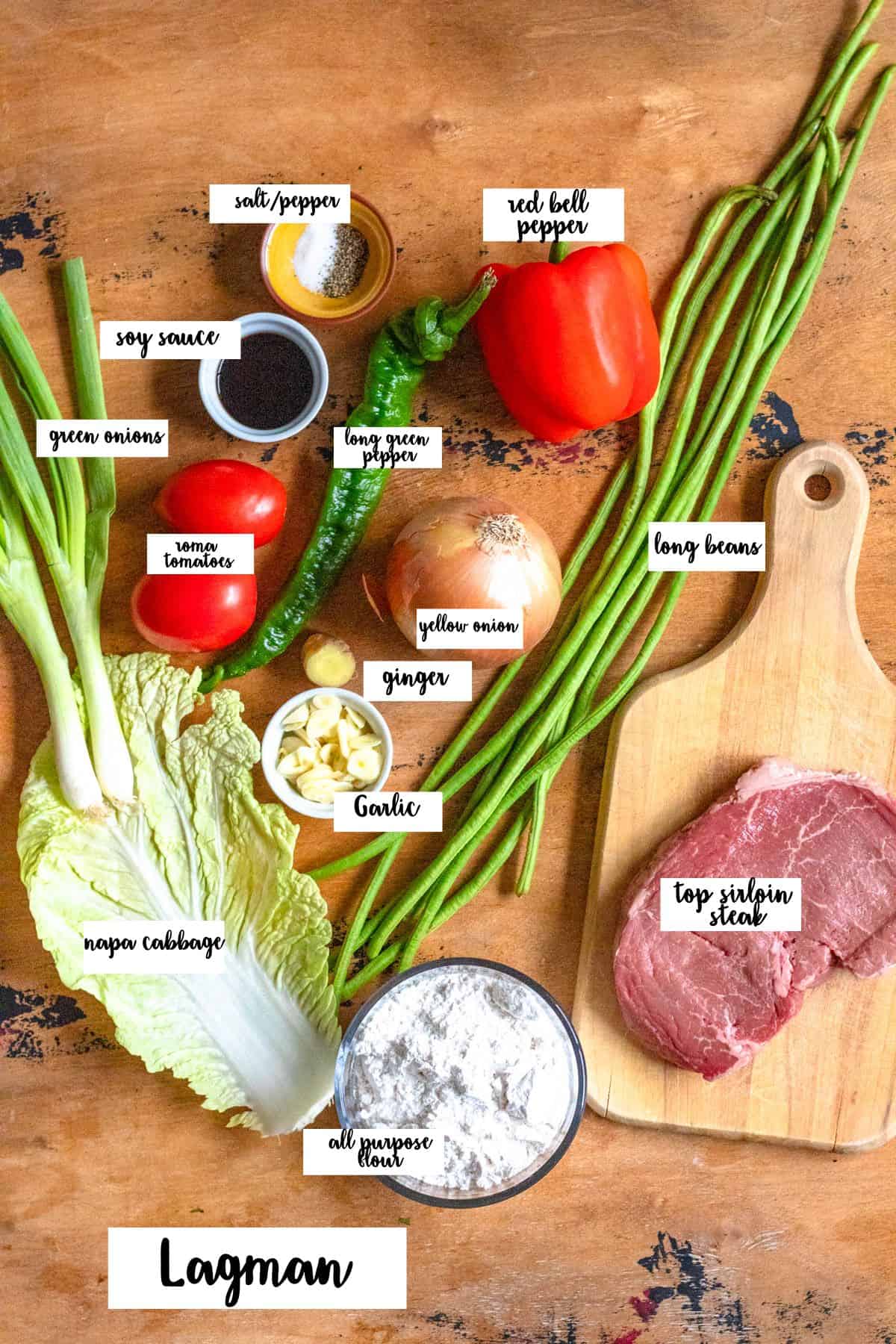
Noodle Ingredients
- All Purpose Flour, Salt, and Vegetable Oil
Substitute
- 2 (14 oz) Packages of Udon Noodles: I had trouble with these special noodles. Many recipes I found said the Chinese noodles are the star of this dish but for whatever reason they would not come together for me. It may not be the most authentic, but I found udon noodles make a quick and easy substitution and the meal is still incredibly delicious.
Stir Fry Ingredients
- Steak: I used top sirloin steak and cut it very thinly.
- Garlic: Fresh chopped for the best results!
- Chinese Cabbage Leaf: Also called Napa Cabbage
- Long Green Beans: You can sub green beans if necessary
- Long Green Pepper: These are peppers with a mild to medium heat range. They are not considered hot pepper but they do add a slightly spicy flavor.
- Chinese Black Vinegar: Optional but delicious. I bought mine on Amazon
- Tomato Paste: Some recipes use this and some do not. It has a very overpowering flavor so keep that in mind when you are deciding whether or not to add it!
How to Make This Recipe
Step One: Prepare the noodles

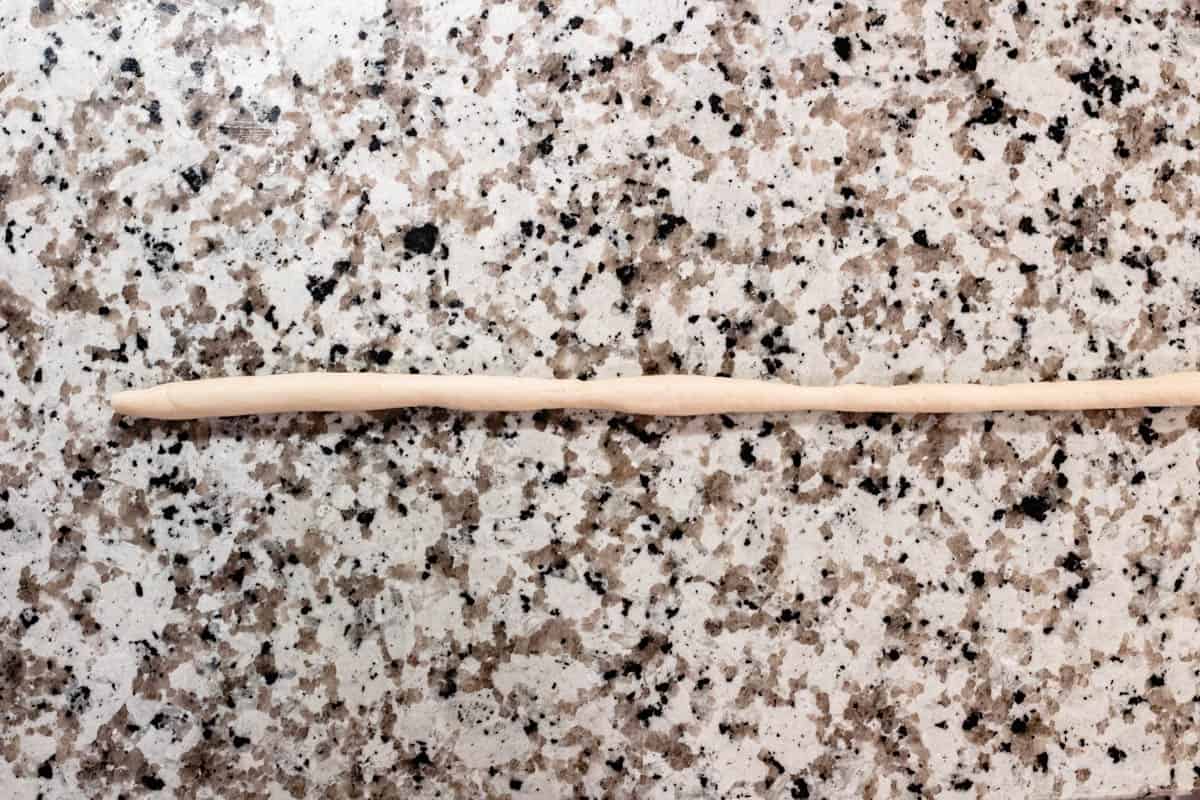
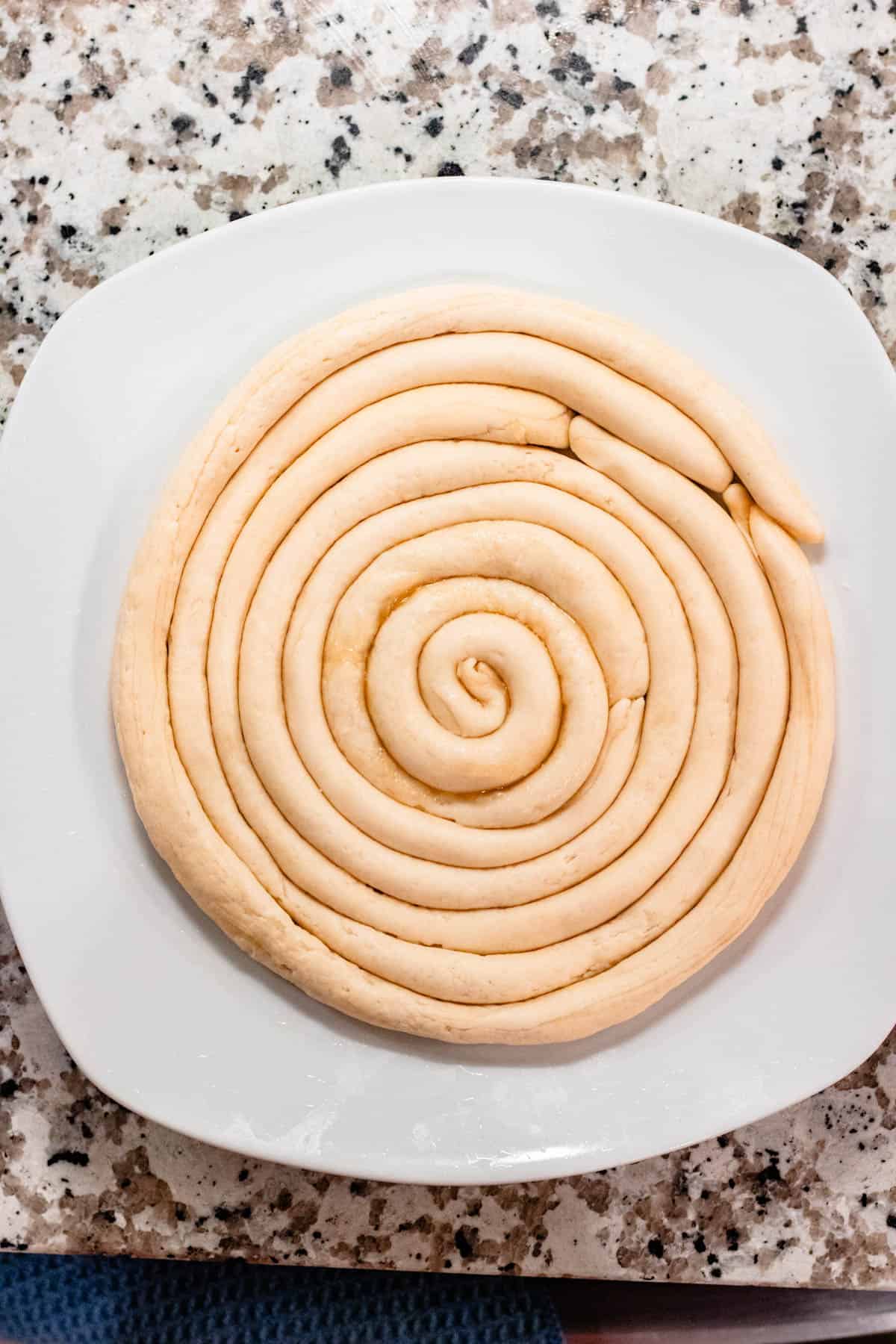
In a medium bowl, add the all-purpose flour and the salt. Mix to combine. Form a well in the center of the flour.
Little by little, pour the water into the well, stirring or mixing with your hands between each addition. Continue to stir the mixture until the dough comes together, adding slightly more or less water depending on the texture.
Once the dough has come together, knead with your hands for about 10 minutes, until the dough is softer and there is no dry flour apparent anywhere.
Place the dough back in the bowl and cover with plastic wrap for 15-20 minutes.
Once the dough has rested, cut the dough into thirds. Brush a dinner plate with vegetable oil as well as brush your countertop with vegetable oil.
Use your hands to gently press each third of the dough to lengthen it a bit.
Using a backward and forward motion, roll the dough across the countertop to uniformly stretch the dough until it is very long and smaller than the width of your finger. Continue for all 3 pieces of dough.
Once the dough is stretched, start at the center of the plate and place the long noodle dough strands in a spiral on the oiled plate. Brush the top with more vegetable oil, then cover the Laghman noodles with plastic wrap and leave it to sit for about 20 minutes while you prepare the stir fry.
Step Two: Make the Stir Fry
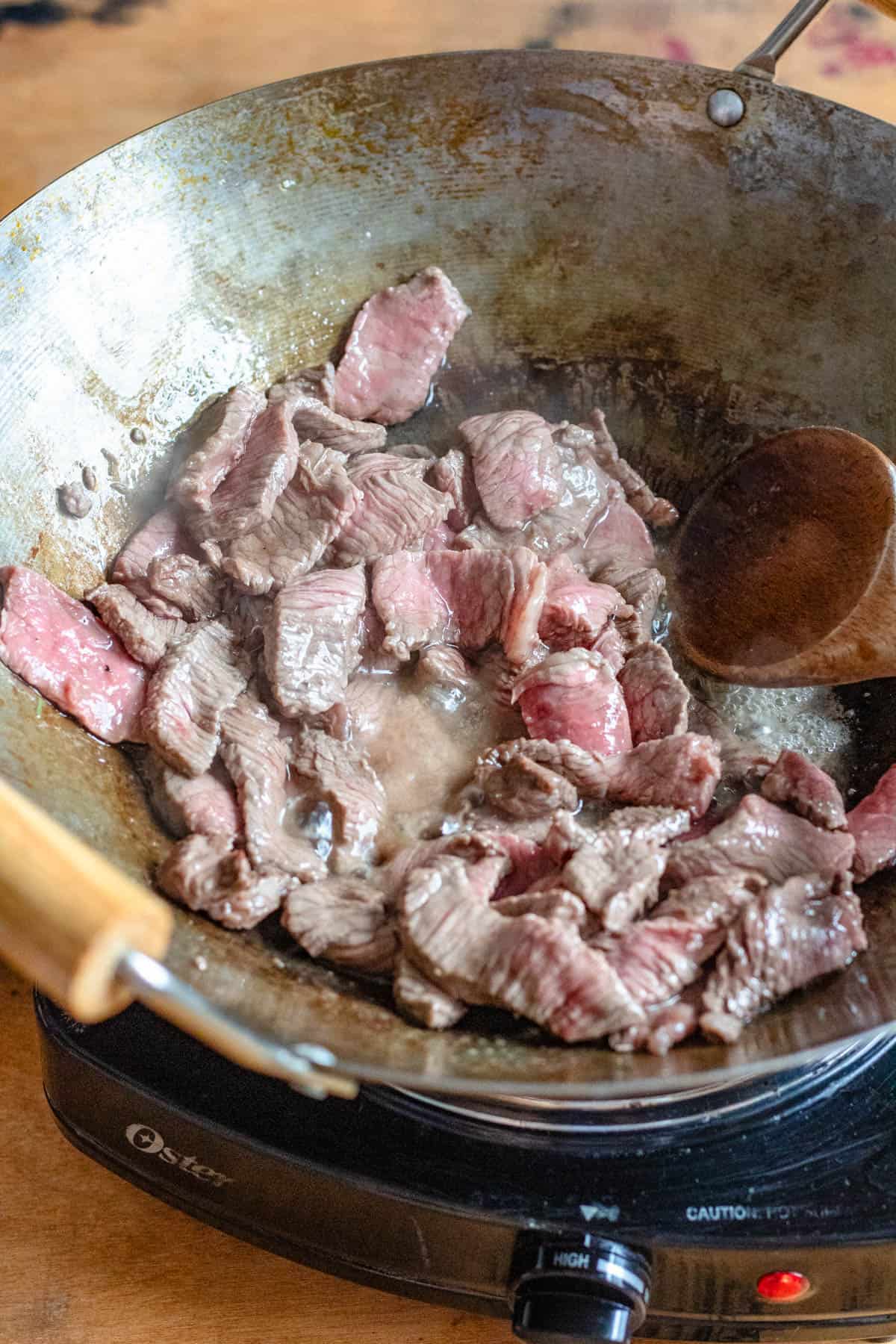
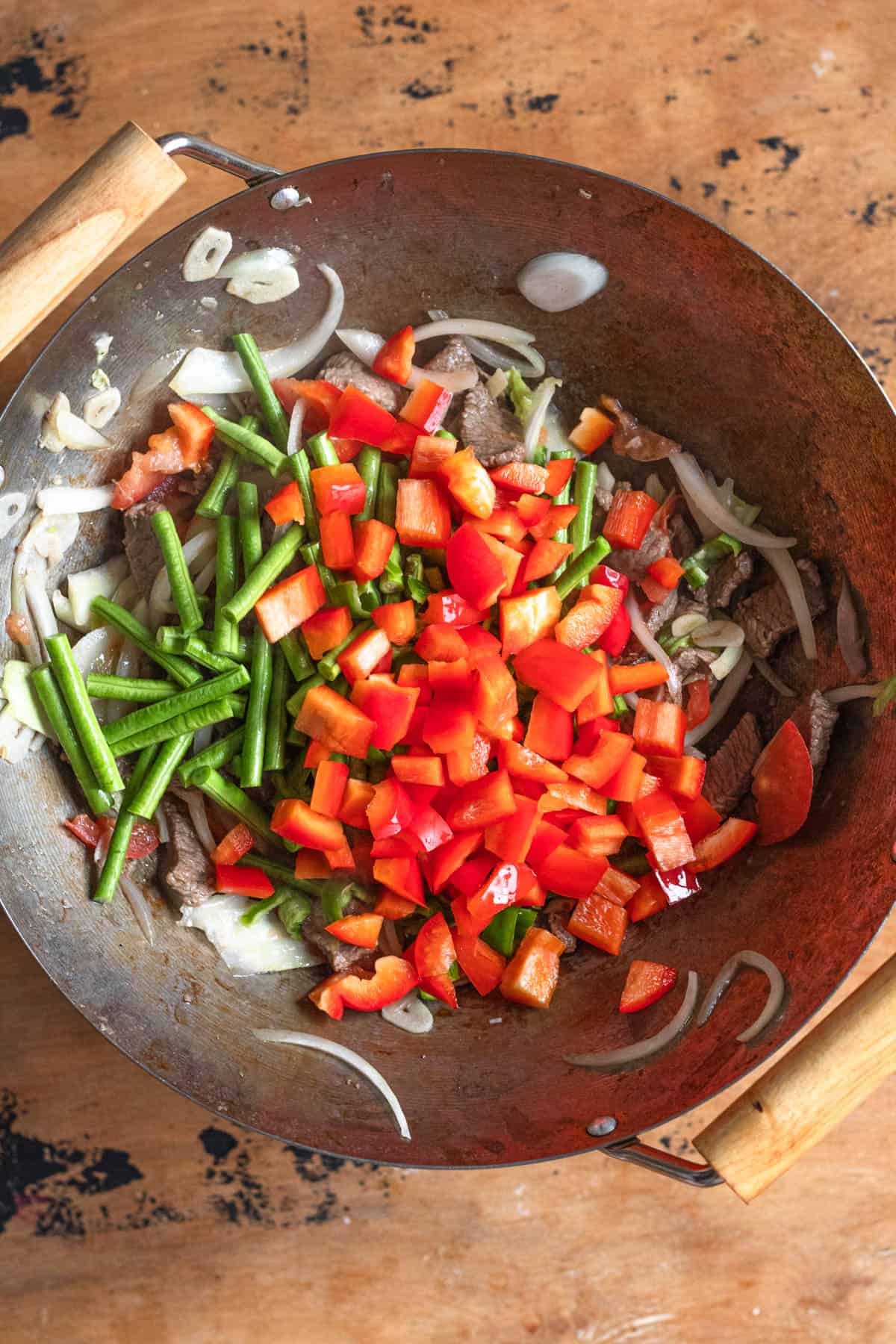
In a large wok or deep frying pan, start by adding the vegetable oil over medium-high heat. Allow it to warm up.
Once the oil is warm, add the beef. Stir fry until the beef is browned on the outside.
If the beef strips release a lot of liquid, drain the liquid from the pan and add more oil to the wok. Then add the garlic and ginger and stir fry for another minute or so until fragrant.
Add the sliced onion, fresh tomatoes, and Chinese cabbage into the pan. Stir fry for 3-4 minutes until softened.
Add the long beans, red bell pepper, green pepper, salt, pepper, and soy sauce, and stir fry again until everything is wilted.
Add the Chinese Black vinegar, green onions, tomato paste, and water and mix to combine. Turn the heat to low and allow the stir fry to stay warm and continue cooking while you prepare the noodles.
Step Three: Cook the Noodles
Salt a large pot of cold water and bring it to a boil. Watch this video for instructions on how to form Lagman noodles from a professional!
When the stir fry is done, come back to the noodles. Starting with the edge of the dough coil, pull the dough through your fingers, stretching the dough even thinner. Continue this for all three pieces.
Place the end of one dough strand in between your forefinger and your thumb. Keeping your hands about 1 ½ feet apart, wrap the dough strands over both hands again and again until all of the dough is used up.
Bang your hands against the table pulling apart as you do so. This is called making the thin noodles “dance” and is meant to strengthen them even thinner.
Do this a few times, then place the full strands of long noodles in the boiling water. Cook the hand-pulled noodles for 2-3 minutes until fully cooked through al dente.
Reserve some pasta water, then drain the remaining water.
Step Four: Serve
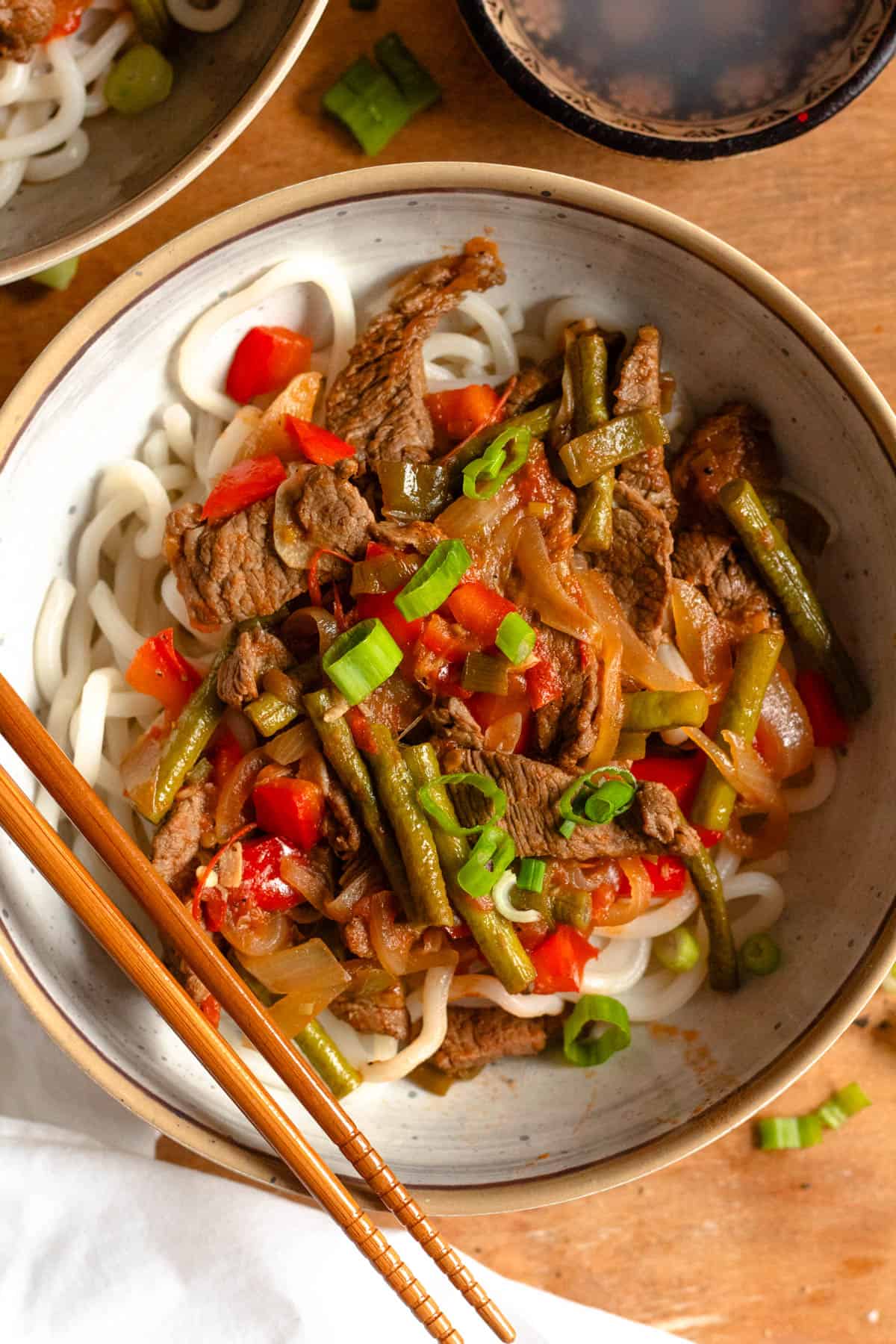
Once the noodles are done, place the cooked noodles in a deep bowl and serve the Lagman stir fry over the top of the ready noodles. Eat together with chopsticks and with a side of pasta water for a traditional serving. Enjoy!
Researched using Nazaket’s Kitchen, Dolan Chick, and Peter’s Food Adventure
Expert Tips
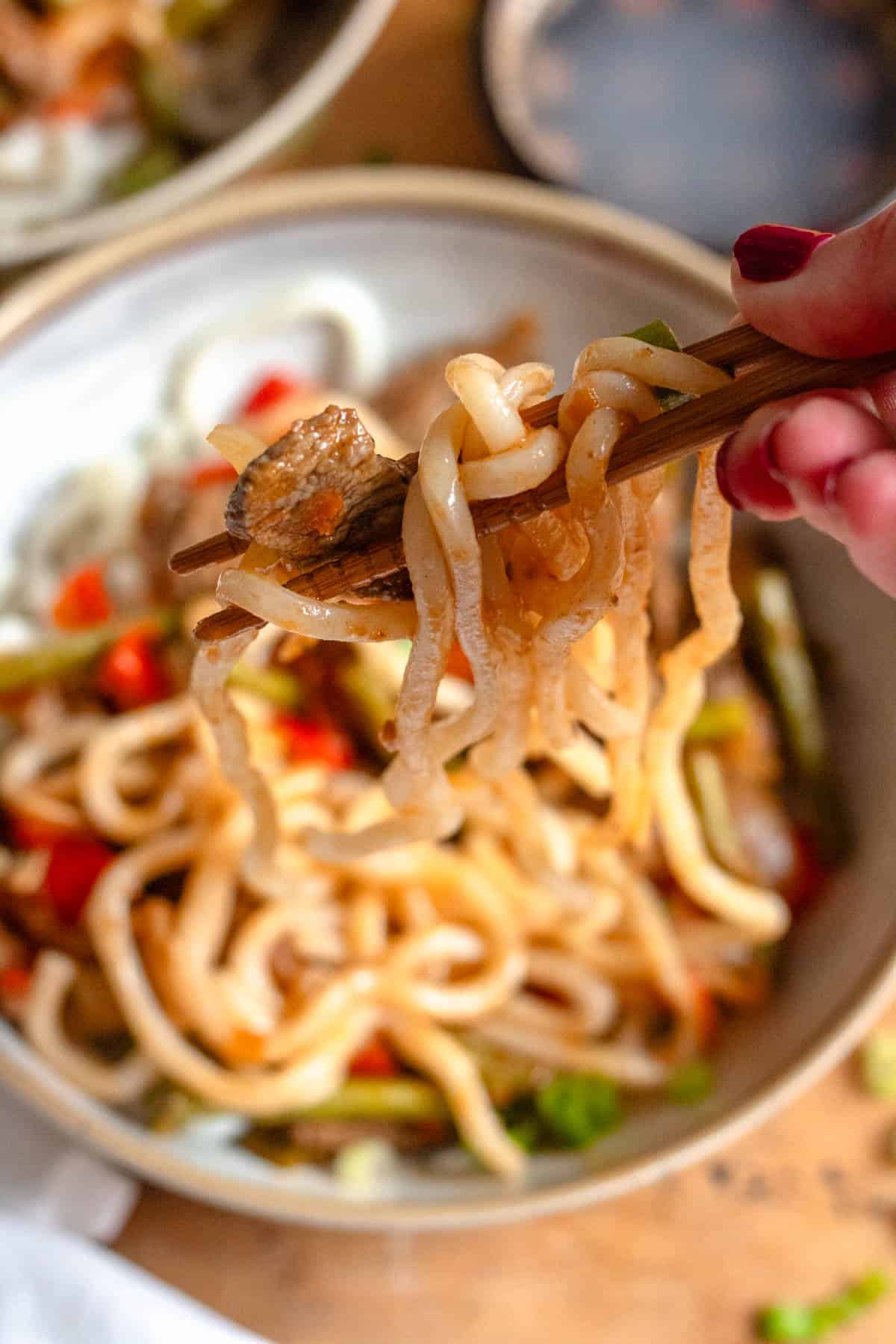
- Try as I might, I could not get the noodles right for this Lagman dish. I have written instructions for the noodles based on the videos I watched and recipes I read, but if noodle success is evading you as it did for me, you can substitute the homemade noodles for udon noodles instead!
- Eat this with chopsticks for the most authentic experience
- Traditionally Lagman is served with noodle water on the side for guests to add to their dish to create as much broth as they like.
Variations
There are many ways to prepare this dish, especially because Lagman has become popular in so many parts of the world.
Some recipes do not use the Chinese Black Vinegar or the Tomato Paste in Lagman. In some recipes, they add chili oil/chili paste. Some recipes do not use long beans or Chinese cabbage. Make whatever changes fit your preferences!
Did you enjoy this Lagman Recipe? If so, make sure to check out these other recipes I picked out just for you:
- Beshbarmak Recipe from Kazakhstan
- Steak Stir Fry from Cambodia
- Shrimp Stir Fry with Noodles
- Beef Yakisoba Recipe

Lagman Recipe
Ingredients
Noodle Ingredients
- 9 oz All Purpose Flour, 250 gram
- ⅛ tsp salt
- ½ cup water, 110 ml
- 2 tbsp Vegetable Oil
- 28 oz Udon Noodles, Substitute for homemade noodles
Stir Fry Ingredients
- ¼ cup vegetable oil, more as necessary
- 14 oz Top Sirloin Steak, sliced thinly
- 4 cloves Garlic, minced
- ½ inch Ginger, minced
- ½ yellow Onion, sliced
- 2 Roma Tomatoes, sliced
- 1 Napa Cabbage/Chinese Cabbage Leaf, sliced
- 8 Long Beans, cut into pieces about 1 inch long
- 1 Red bell pepper, diced
- 1 long green pepper, sliced with seeds removed
- ½ tsp freshly cracked Black Pepper
- Salt, to taste
- 1 tbsp soy sauce
- 1 Tbsp Chinese Black vinegar
- 1 Green Onions, sliced
- 1 tbsp Tomato paste
- ¼ cup Water
Instructions
Noodle Instructions
- In a medium bowl, add the 9 oz all purpose flour and ⅛ tsp salt. Mix to combine. Form a well in the center of the flour.
- Little by little, pour the water into the well, stirring or mixing with your hands between each addition. Continue to stir the mixture until the dough comes together, adding slightly more or less water depending on the texture.
- Once the dough has come together, knead with your hands for about 10 minutes, until the dough is softer and there is no dry flour apparent anywhere.
- Place the dough back in the bowl and cover with plastic wrap for 15-20 minutes.
- Once the dough has rested, cut the dough into thirds. Brush a dinner plate with vegetable oil as well as brush your countertop with vegetable oil.
- Use your hands to gently press each third of dough to lengthen it a bit.
- Using a backward and forward motion, roll the dough across the countertop to uniformly stretch the dough until it is very long and smaller than the width of your finger. Continue for all 3 pieces of dough.
- Once the dough is stretched, start at the center of the plate and place the long dough strands in a spiral. Brush the top with more vegetable oil, then cover it with plastic wrap and leave it to sit for about 20 minutes while you prepare the stir fry.
Stir Fry Instructions
- In a large wok or frying pan, start by adding ¼ cup vegetable oil over medium-high heat. Allow it to warm up.
- Once the oil is warm, add the 14 oz beef. Stir fry until the beef is browned on the outside.
- If the beef released a lot of liquid, drain the liquid from the pan and add more oil into the wok. Then add the 4 cloves garlic and ½" minced ginger and stir fry for another minute or so until fragrant.
- Add the ½ sliced yellow onion, 2 fresh sliced Roma tomatoes and the sliced chinese cabbage into the pan. Stir fry for 3-4 minutes until softened.
- Add the 8 sliced long beans, diced red pepper, sliced green pepper, salt to taste, ½ tsp pepper, and 1 tbsp soy sauce, and stir fry again until everything is wilted.
- Add the 1 tbsp Chinese Black vinegar, sliced green onion, 1 tbsp tomato paste, and ¼ cup water and mix to combine. Turn the heat to low and allow the stir fry to stay warm and continue cooking while you prepare the noodles.
Creating the Noodles
- Salt a pot of water and bring it to a boil. Watch this video for instructions on how to form Lagman noodles from a professional!
- When the stir fry is done, come back to the noodles. Starting with the edge of the spiral, pull the dough through your fingers, stretching the dough even thinner. Continue this for all three pieces.
- Place the end of one dough strand in between your forefinger and your thumb. Keeping your hands about a 1 ½ feet apart, wrap the dough strands over both hands again and again until all of the dough is used up.
- Bang your hands against the table pulling apart as you do so. This is called making the noodles “dance” and is meant to strengthen them even thinner.
- Do this a few times, then place the full strands in the water. Cook for 2-3 minutes until fully cooked through.
- Reserve some pasta water, then drain the remaining water.
Serving
- Once the noodles are done, place them in a bowl and serve the stir fry over the top of the noodles. Eat together with chopsticks and with a side of pasta water for a traditional serving. Enjoy!
Notes
- Noodle Ingredients – All Purpose Flour, Salt, and Vegetable Oil
- Substitute – 2 (14 oz) Packages of Udon Noodles: I had trouble with these special noodles. Many recipes I found said the Chinese noodles are the star of this dish but for whatever reason they would not come together for me. It may not be the most authentic, but I found udon noodles make a quick and easy substitution and the meal is still incredibly delicious.
- Stir Fry Ingredients
- Steak: I used top sirloin steak and cut it very thinly.
- Garlic: Fresh chopped for the best results!
- Chinese Cabbage Leaf: Also called Napa Cabbage
- Long Green Beans: You can sub green beans if necessary
- Long Green Pepper: These are peppers with a mild to medium heat range. They are not considered a hot pepper but they do add a slightly spicy flavor.
- Chinese Black Vinegar: Optional but delicious. I bought mine on Amazon
- Tomato Paste: Some recipes use this and some do not. It has a very overpowering flavor so keep that in mind when you are deciding whether or not to add it!
- Try as I might, I could not get the noodles right. I have written instructions for the noodles based off of the videos I watched and recipes I read, but if noodle success is evading you like it did for me, you can substitute the homemade noodles for udon noodles instead!
- Eat this with chopsticks for the most authentic experience
- Traditionally this dish is served with noodle water on the side for guests to add to their dish to create as much broth as they like.






Leave a Reply